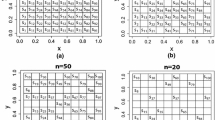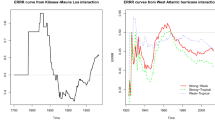Abstract
It is often of interest to model the incidence and duration of threshold exceedance events for an environmental variable over a set of monitoring locations. Such data arrive over continuous time and can be considered as observations of a two-state process yielding, sequentially, a length of time in the below threshold state followed by a length of time in the above threshold state, then returning to the below threshold state, etc. We have a two-state continuous time Markov process, often referred to as an alternating renewal process. The process is observed over a truncated time window and, within this window, duration in each state is modeled using a distinct cumulative intensity specification. Initially, we model each intensity over the window using a parametric regression specification. We extend the regression specification adding temporal random effects to enrich the model using a realization of a log Gaussian process over time. With only one type of renewal, this specification is referred to as a Gaussian process modulated renewal process. Here, we introduce Gaussian process modulation to the intensity for each state. Model fitting is done within a Bayesian framework. We clarify that fitting with a customary log Gaussian process specification over a lengthy time window is computationally infeasible. The nearest neighbor Gaussian process, which supplies sparse covariance structure, is adopted to enable tractable computation. We propose methods for both generating data under our models and for conducting model comparison. The model is applied to hourly ozone data for four monitoring sites at different locations across the United States for the ozone season of 2014. For each site, we obtain estimated profiles of up-crossing and down-crossing intensity functions through time. In addition, we obtain inference regarding the number of exceedances, the distribution of the duration of exceedance events, and the proportion of time in the above and below threshold state for any time interval.








Similar content being viewed by others
Notes
Data are available for download at http://aqsdr1.epa.gov/aqsweb/aqstmp/airdata/download_files.html.
References
Achcar JA, Fernández-Bremauntz AA, Rodrigues ER, Tzintzun G (2008) Estimating the number of ozone peaks in Mexico City using a non-homogeneous Poisson model. Environmetrics 19(5):469–485
Achcar JA, Rodrigues ER, Tzintzun G (2011) Using non-homogeneous poisson models with multiple change-points to estimate the number of ozone exceedances in mexico city. Environmetrics 22(1):1–12
Achcar JA, Coelho-Barros EA, de Souza RM (2016) Use of non-homogeneous Poisson process (NHPP) in presence of change-points to analyze drought periods: a case study in Brazil. Environ Ecol Stat 23(3):1–15
Banerjee S, Carlin BP, Gelfand AE (2014) Hierarchical modeling and analysis for spatial data. CRC Press, Boca Raton
Beichelt F (2006) Stochastic processes in science, engineering and finance. CRC Press, Boca Raton
Bell ML, McDermott A, Zeger SL, Samet JM, Dominici F (2004) Ozone and short-term mortality in 95 US urban communities, 1987–2000. J Am Med Assoc 292(19):2372–2378
Bell ML, Dominici F (2008) Effect modification by community characteristics on the short-term effects of ozone exposure and mortality in 98 US communities. Am J Epidemiol 167(8):986–997
Berman M (1981) Inhomogeneous and modulated gamma processes. Biometrika 68(1):143–152
Birolini A (2012) On the use of stochastic processes in modeling reliability problems, vol 252. Springer, New York
Bloomer BJ, Stehr JW, Piety CA, Salawitch RJ, Dickerson RR (2009) Observed relationships of ozone air pollution with temperature and emissions. Geophys Res Lett 36(9), L09803. doi:10.1029/2009GL037308
Chelani AB (2014) Irregularity analysis of CO, NO\(_2\) and O\(_3\) concentrations at traffic, commercial and low activity sites in Delhi. Stoch Environ Res Risk Assess 28(4):921–925
Coles S, Bawa J, Trenner L, Dorazio P (2001) An introduction to statistical modeling of extreme values, vol 208. Springer, New York
Cox DR (1972) The statistical analysis of dependencies in point processes. In: Lewis PAW (ed) Stochastic point processes. Wiley, New York, pp 55–66
Cressie N (1993) Statistics for spatial data. Wiley
Datta A, Banerjee S, Finley AO, Gelfand AE (2016a) Hierarchical nearest-neighbor Gaussian process models for large geostatistical datasets. J Am Stat Assoc Ser B (Stat Methodol) 111(514):800–812
Datta A, Banerjee S, Finley AO, Hamm NA, Schaap M (2016b) Nonseparable dynamic nearest neighbor Gaussian process models for large spatio-temporal data with an application to particulate matter analysis. Ann Appl Stat 10(3):1286–1316
Diggle PJ (2013) Statistical analysis of spatial and spatio-temporal point patterns. CRC Press, Boca Raton
García-Díaz JC (2011) Monitoring and forecasting nitrate concentration in the groundwater using statistical process control and time series analysis: a case study. Stoch Environ Res Risk Assess 25(3):331–339
Gryparis A, Coull BA, Schwartz J, Suh HH (2007) Semiparametric latent variable regression models for spatiotemporal modelling of mobile source particles in the greater Boston area. J R Stat Soc Ser C (Appl Stat) 56(2):183–209
Guarnaccia C, Quartieri J, Tepedino C, Rodrigues ER (2015) An analysis of airport noise data using a non-homogeneous poisson model with a change-point. Appl Acoust 91:33–39
Huerta G, Sansó B, Stroud JR (2004) A spatiotemporal model for Mexico City ozone levels. J R Stat Soc Ser C (Appl Stat) 53(2):231–248
Illian J, Penttinen A, Stoyan H, Stoyan D (2008) Statistical analysis and modelling of spatial point patterns, vol 70. Wiley, Hoboken
Jacob DJ, Winner DA (2009) Effect of climate change on air quality. Atmos Environ 43(1):51–63
Lasko TA (2014) Efficient inference of Gaussian-process-modulated renewal processes with application to medical event data. In: Proceedings of the uncertainty in artificial intelligence (UAI), vol 2014. NIH Public Access, pp 469–476
Leadbetter MR (1991) On a basis for ‘Peaks over Threshold’ modeling. Stat Probab Lett 12(4):357–362
Lervolino I, Giorgio M, Polidoro B (2014) Sequence-based probabilistic seismic hazard analysis. Bull Seismol Soc Am 104(2):1006–1012
Murray I, Adams RP, MacKay DJ (2010) Elliptical slice sampling. J Mach Learn Res Workshop Conf Proc (AISTATS) 9:541–548
Norris JR (1998) Markov chains. Number 2008. Cambridge University Press, Cambridge
O’Connor JR, Roelle PA, Aneja VP (2005) An ozone climatology: relationship between meteorology and ozone in the Southeast USA. Int J Environ Pollut 23(2):123–139
Rodrigues ER, Gamerman D, Tarumoto MH, Tzintzun G (2014) A non-homogeneous poisson model with spatial anisotropy applied to ozone data from Mexico City. Environ Ecol Stat 22(2):393–422
Sahu SK, Gelfand AE, Holland DM (2007) High-resolution space-time ozone modeling for assessing trends. J Am Stat Assoc 102(480):1221–1234
Teh YW, Rao V (2011) Gaussian process modulated renewal processes. In: Shawe-Taylor J, Zemel RS, Bartlett PL, Pereira F, Weinberger KQ (eds), Advances in neural information processing systems 24. Curran Associates, Inc, pp 2474–2482
Thompson ML, Reynolds J, Cox LH, Guttorp P, Sampson PD (2001) A review of statistical methods for the meteorological adjustment of tropospheric ozone. Atmos Environ 35(3):617–630
Trivedi KS (2001) Probability and statistics with reliability, queuing and computer science applications. Wiley, Hoboken
U.S. Environmental Protection Agency (2011) Ozone health risk assessment for selected urban areas. EPA Office of Air Quality Planning and Standards, Research Triangle Park, NC, EPA/452/R-07-009
U.S. Environmental Protection Agency (2013) 2013 Final report: integrated science assessment of ozone and related photochemical oxidants. U.S. Environmental Protection Agency, Washington, DC, EPA/600/R-10/076F
Waller LA, Gotway CA (2004) Applied spatial statistics for public health data, vol 368. Wiley, Hoboken
World Health Organization (2006) Air quality guidelines: global update 2005: particulate matter, ozone, nitrogen dioxide, and sulfur dioxide. World Health Organization, Geneva
Acknowledgements
The work of the first author was supported in part by University of Missouri Research Board and the US EPA’s Office of Research and Development under EPA contract EP-13-D-000257.
Author information
Authors and Affiliations
Corresponding author
Additional information
Disclaimer: The U.S. Environmental Protection Agency through its Office of Research and Development partially collaborated in this research. Although it has been reviewed by the Agency and approved for publication, it does not necessarily reflect the Agency’s policies or views.
Appendix
Appendix
See Fig. 9.
Rights and permissions
About this article
Cite this article
Schliep, E.M., Gelfand, A.E. & Holland, D.M. Alternating Gaussian process modulated renewal processes for modeling threshold exceedances and durations. Stoch Environ Res Risk Assess 32, 401–417 (2018). https://doi.org/10.1007/s00477-017-1417-9
Published:
Issue Date:
DOI: https://doi.org/10.1007/s00477-017-1417-9





